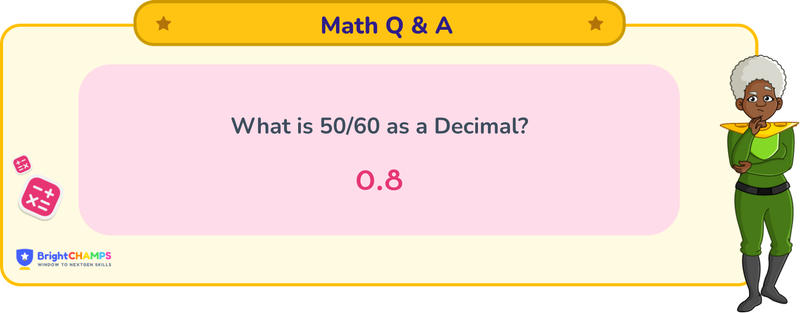Summarize this article:
 277 Learners
277 LearnersLast updated on August 5, 2025
50/60 as a Decimal

This is a simple question on decimal conversion. Firstly, we need to understand fractions and decimals. A fraction represents a part of a whole. It has two parts: the numerator (the number on the top), which represents how many parts we have, and the denominator (the number below), which shows how many parts make up the whole. A decimal is a way to represent numbers that are not whole, using a decimal point (.) to separate the whole part from the fractional part. The numbers to the left of the decimal point represent the whole, and those to the right represent the fractional part.

What is 50/60 as a decimal?

Answer
50/60 in decimals can be simplified first and then written as 0.8333... It is a recurring decimal, indicating that some digits will repeat indefinitely.
Explanation
To convert 50/60 to a decimal, we first simplify the fraction. The greatest common divisor of 50 and 60 is 10, so dividing both the numerator and the denominator by 10 gives us 5/6. Now, let's convert 5/6 to a decimal using long division.
Step 1: Identify the numerator and denominator, where the numerator (5) is the dividend and the denominator (6) is the divisor.
Step 2: Since 5 is smaller than 6, we will use the decimal method. We add a decimal point and a zero, making it 50.
Step 3: Divide 50 by 6 to see how many times 6 fits into 50.
Step 4: 50 divided by 6 is 8, remainder 2. Write 8 in the quotient and bring down another 0 to make it 20.
Step 5: Divide 20 by 6, which goes 3 times (6 × 3 = 18), remainder 2. Bring down another 0 to make it 20 again and repeat the division step. This division process continues indefinitely, indicating a recurring decimal.
The decimal representation of 50/60 (or 5/6) is approximately 0.8333...

Important Glossaries for 50/60 as a decimal
- Fraction: A numerical quantity that is not a whole number, representing a part of a whole.
- Decimal: A number that uses the base ten and includes a decimal point to separate the whole part from the fractional part.
- Simplify: The process of reducing a fraction to its simplest form by dividing the numerator and the denominator by their greatest common divisor.
- Recurring Decimal: A decimal fraction in which a figure or group of figures is repeated indefinitely.
- Greatest Common Divisor: The largest positive integer that divides each of the integers without a remainder.




